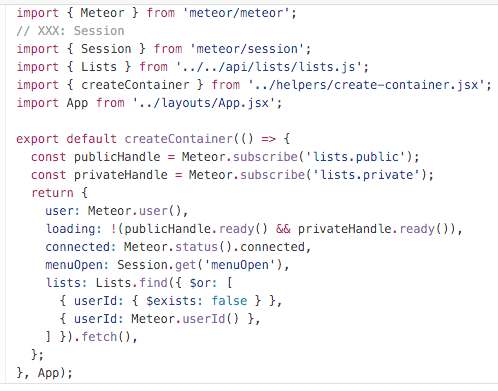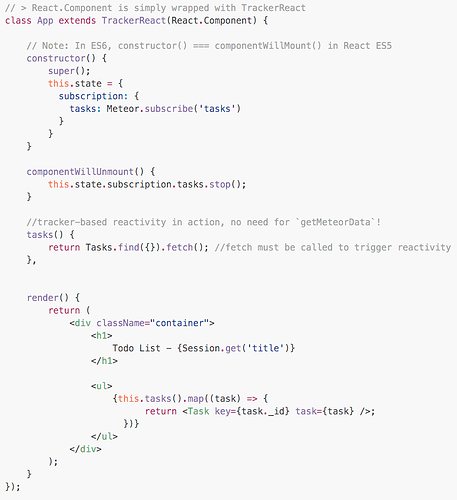@tmeasday am not really sure where this was expressed elsewhere. But TrackerReact is an overhaul proposal of getMeteorData - a practice wise outdated mixin - and not a proposal of best practice.
The Example is for showcasing its functionality. So please don’t over read this part:
As of using TrackerReact, you don’t put reactive data sources next to html and other components, you follow best practice and return one single component in which you pass reactive data sources down as props. It’s best practice. A practice that anyone can reason about after they understood the role of meteor in that context.
Rendering
As of re-rendering, you should check MeteorGetData. It re-runs all the time. @faceyspacey elaborated that in an older thread a while ago; also regarding Trackers quirks. TrackerReact runs once. That’s it.
There is also no mix of the view and data layer. Meteor provides reactive states that change while the component is rendered. Wrapping all that away under a “getMethod” that is de facto not a getter - to than return its value under a data property - instead of simply using class methods is pretty far away from flux. It is not even maping to state like you would in redux. To me it looks like a prototypical approach (getMeteorData) carried over on accident without being revisited.
Comprehensabilty, than Best Practice
Because after all it boils down to this: I report that TrackerReact seems to let experienced developers grasp much quicker the value proposition of meteor for react and replicate best practice with it. @joshowens, running space dojo, reports newbies understand more quickly what’s going on between meteor and react. Searching through the forum for TrackerReact and looking at the response of the past it seems quite a few people seem to feel more comfortable to see a plain connection between meteor and react.
So my question is: Where is this resistance coming from?
To revisit getMeteorData is clearly useful before the 1.3 release and was asked for with its first emergence. The abandonment of mixins is also a good excuse to really check its appropriateness.
So My goal is not to push TrackerReact as primary adoption but to have a discussion about a very transparent, low level implementation of getMeteorData that is as easily understood as TrackerReact. With that, one can build abstractions and follow best practices. Also in the guide. But not the other way around.
Right now: Just build a container creator with TrackerReact and you have both. Best practice and great reasoning what’s going on.
-> I am excited to see the react-meteor-data demo. But we need an easy no-scaffold/wrapper implementation to onboard people. Would love to chat with you about my experiences one time.


